60-6934 (YF-12A)
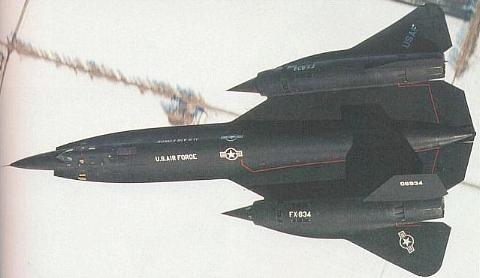
14 August 1966
60-6934 (YF-12A)

14 August 1966
Loss #6 60-6934
(YF-12A) This aircraft, the 1st YF-12A built, was seriously damaged
as
a result of internal systems overheating on 14 August 1966 during a
landing accident at Edwards AFB. The rear half was later used to build
the SR-71C (61-7981) which flew for the first time on March 14 1969. The
airframe remained intact but the damage to internal systems was beyond
repair. What happened to the forward section is anybody's guess, but the
aft end lives on as part of SR-71C #981. The pilot was Colonel Vern Henderson
and the FCO was Capt Jim Cooney. LAC #1001 (934) flew 180.9 hours total
flight time prior to the crash.
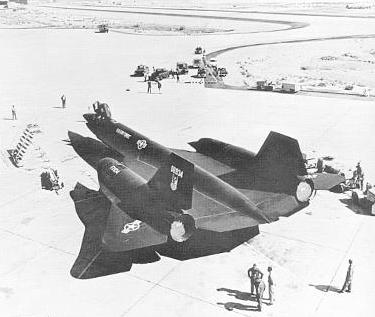
(USAF Photo)
60-6928 (A-12)
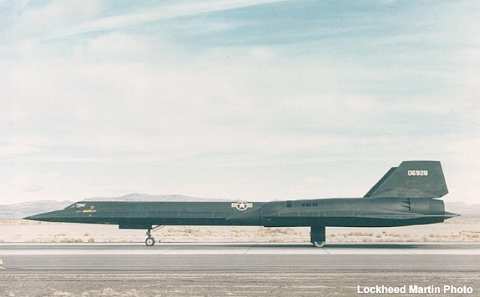
5 January 1967
Loss #7 60-6928
(A-12) Article 125.This aircraft was lost on 5 January 1967 during a training
sortie flown from Groom Lake, Area 51, Nevada. Walter
L. Ray, an employee of the CIA, joined Lockheed as a civilian pilot on
November 07, 1962. During #928's final flight, Ray did not received a full
fuel load from the tanker due to a second aircraft (chase plane) requiring
fuel. He determined that he had sufficient fuel to return to Groom Lake.
He could have diverted to Albuquerque, NM. He declared an emergency
but the aircraft ran out of fuel only minutes before landing at Groom Lake.
The official accident report attributed the crash to a malfunctioning fuel
quantity gauge. However, in his radio transmission prior to ejecting he
stated "I have a loss of fuel and I do not know where it is going; I think
I can make it (Groom Lake)". CIA pilot Walter L. Ray was forced
to eject. Unfortunately the ejection seat separation sequence (which should
have occurred at 16,000 feet) malfunctioned and Ray was killed on impact
with the ground, still strapped to his seat. The automatic sequence for
separating the pilot from the seat even though the pilot may be unconscious
definitely was defective. Additionally, the pilot was not wearing his fitted
pressure suit but rather one that was larger which may have been a contributing
factor. LAC #125 (928) flew 202 flights for 334.9 hours
total flight time prior to the crash. Walter L. Ray was the first CIA pilot
killed in the line of duty and is so honored in the "Book of Honor", CIA
Headquarters in McLean, Va. Tom Mahood has an excellent web page dedicated
to his quest for the crash location of this aircraft. Go here to read his
story: "The Hunt for
928".
61-17950 (SR-71A)
10 January 1967
Loss #8 61-17950
(SR-71A) The prototype SR-71 was lost on 10 January 1967 at Edwards during
an anti-skid
braking system evaluation. The main landing gear tires blew out
and the resulting fire in the magnesium wheels spread to the rest of the
aircraft as it ran off the end of the runway. Lockheed test pilot Art Peterson
survived.
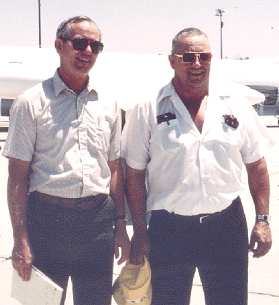
(Photo courtesy Jim Fitzgerald)
Frank Rowe and Test Pilot, Art Peterson on the Right
(Lockheed Photo)
#950 Engine Nacelle Remnants in a hanger at Edwards
61-17966 (SR-71A)

(No photos are know to exist)
13 April 1967
Loss #9 61-17966 (SR-71A) Lost on the evening of 13 April 1967 after the aircraft entered a subsonic, high-speed stall. Pilot Captain Earle M. Boone and RSO Captain Richard E. (Butch) Sheffield ejected safely. The incident occurred 8 NM SE of Las Vegas, New Mexico (not Nevada). Sheffield estimates that #966 had less than 50 hours of flight time on her at the time of the crash. A URL for a detailed search by Robb Magley of the crash site is available here: http://members.fortunecity.com/aspen29
The Air Force Mishap Report:
1. On 13 April 1967, Major Earle M. Boone, FR53969, Pilot, and Major Vick, RSO, were schedules to fly SR-71A,
serial number 61-7959, on a Combat Crew Training Mission. Take-off was scheduled for 1035 Pacific Standard
Time. On the day preceding [sic] the flight Major Richard E. Sheffield, FV3039867, was selected to replace Major
Vick, who was suffering from a cold and unable to fly. Major Boone and Major Sheffield attended the general
briefing 12 April 1967. After briefing, the scheduled take-off time and aircraft were changed due to maintenance
difficulties. This resulted in aircraft 61-7966 (ASPEN 29) being scheduled for a 1735 PST take-off. The original
mission route and training accomplishments remained as briefed.
2. Flight planning was completed by the 9th Strategic Reconnaissance Wing Flight Planning Section. Crew briefing
was in accordance with existing policies and was conducted by the 1st Strategic Reconnaissance Squadron mission
briefing officer. The aircraft was preflighted by qualified maintenance crews, using established procedures, and no
discrepancies were apparent. Prior to flight, the flight crew filed their flight clearance and reported to the
Physiological Support Division building at the scheduled time. The pre-flight physical examination, pre-flight meal and
suit-up operations were completed without discrepancy. The crew was driven to the aircraft and the hook-up
completed, and checked, without deviation. Prior to start, Engine Start, Taxi and all pre-take-off checks were routine
and take-off was on time. The take-off and initial climb appeared normal to the launch crew.
3. Climb, acceleration and the first Mach 2.80, high altitude cruise leg were uneventful. Both crew members
reported moderate Clear Air Turbulence between Flight Levels 530 and 570. The pilot noted the left Compressor
Inlet Pressure indicating 1 to 1.5 PSI below the desired value and the right Compressor Inlet Pressure indicating 2 to
3 PSI below the desired value during acceleration through Mach 2.30. At Mach 2.80 both CIP indications were
normal for the cruise condition. The descent from FL 700 and the Air Refueling rendezvous with CISCO 53 were
normal with initial contact established at 0237Z, 74 nautical miles short of the End Air Refueling point at FL260. The
delay in initial air refueling contact resulted from failure of the Air to Air TACAN rendezvous equipment to function
properly. Tanker/receiver DME contact could not be established, as a result tanker/receiver separation could not be
accurately determined and a slower than normal closure rate resulted. Maximum onload was scheduled and
completed with 65,000 pounds transferred during one continuous contact. Due to delay in initial contact, a left turn
was required at the End Air Refueling Point, fuel transfer was completed on the air refueling reciprocal heading at
025130Z and approximately FL250. The Air Refueling was reported normal by both the tanker and receiver crew.
Receiver fuel quantity indicated 82,300 pounds at disconnect. This amount is higher than normal for the SR-71 but
consistent with past fuel indications in this aircraft. After completion of Air Refueling the receiver cleared the
contact position downward and to the left. The tanker received ARTC clearance and cleared the refueling track by
initiating a left turn and establishing a climb toward a cleared cruise altitude of FL370. Major Boone increased power
to minimum AB and started a 200 degree right turn at approximately FL240. During this time, the aircraft
accelerated from approximately Mach 0.82 to approximately Mach 0.90. During the turn the pitch autopilot was
engaged in the attitude hold mode and the roll autopilot engaged and Auto Nav mode selected. Mach 0.90 was
maintained during the turn and altitude varied as permitted by available thrust. Major Sheffield had difficulty
contacting Albuquerque center for climb clearance. Radio contact was established and climb clearance received at
0254:30Z with ASPEN 29 apparently in a right turn and 10 NM southwest of Las Vegas, N.M. VORTAC.
Immediately following this clearance ASPEN 29 squawked IFF/SIF IDENT and acknowledge climbing to above
FL600. At 0256Z the Albuquerque Center Sector 14 controller heard an unidentified transmission: "OK, let's go." At
0257Z Albuquerque attempted voice contact with ASPEN 29 to no avail. At 0258Z the radar target, identified as
ASPEN 29 disappeared from the sector radar scope approximately 10 NM southeast of Las Vegas, N.M.
VORTAC. Total flight time from take-off until final impact was one hour twenty three minutes based upon data
supplied by Albuquerque FAA Center. Both crew members ejected successfully.
Search and Rescue:
1. Search and rescue response was almost immediate. The tanker CISCO 53 orbited the area immediately upon
notification and picked up RSO survival radio and strobe light. He set up a track over the RSO and acted as airborne
relay to other aircraft. ADF fixes were successful on the tone mode. First ground parties in the area were local law
enforcement agencies and civilian population. Area secured by local law enforcement at the request of military. A
random search was instituted for crew until arrival of Kirtland rescue mission commander, who organized ground
and air search. Rescue parties came within 1/2 mile of crew members but were hindered by terrain, fences, and
darkness. CISCO 53 directed rescue H-43 to general area of RSO until URC-11 survival radio contact was made.
RSO directed helicopter to pick up pilot. Rescue time from incident to pick up was 2+45 hours. Helicopter and
ground parties continued search for pilot all night.
2. The helicopter came very close to pilot as he was walking toward wreck site. At one point helicopter passed over
pilot standing on a road at telephone pole light. Pilot felt he was sighted in helicopter searchlight and expected
pick-up. Helicopter never spotted pilot despite wear of silver coated garment and a white helmet. Pilot effected self
rescue and walked into wreck site 9+15 hours after incident.
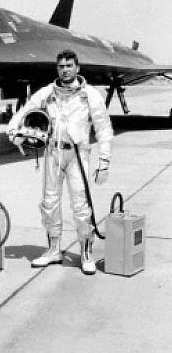
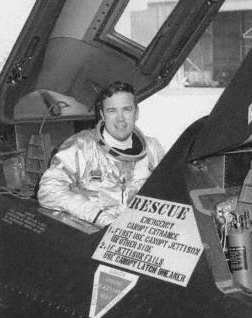
Captain Earle M. Boone, Pilot & Captain Richard E. (Butch) Sheffield, RSO
(Article courtesy The Appeal Democrat:)
(Courtesy The Sacramento Bee)
61-17965 (SR-71A)

(Photo courtesy Tom O'Neill via Habu.Org)
25 October 1967
Loss #10 61-17965 (SR-71A) This aircraft was lost on 25 October 1967 after an Inertial Navigation System (INS) platform failed, leading to erroneous attitude information being displayed in the cockpit. During a night flight, the INS gyro had tumbled. There were no warning lights to alert pilot Captain Roy L. StMartin and RSO Captain John F. Carnochan. In total darkness, in a steep dive and no external visual references available, the crew had little alternative. They both ejected safely. The incident occurred near Lovelock, Nevada.
The following data was derived from www.Habu.Org (with permission) :
The crash site was discovered on January 9, 1999, by Peter Merlin and Tony Moore. Here is the official report of the accident, courtesy of Peter Merlin:
SR-71 serial number 61-7965, call sign "ASPEN 28", departed Beale AFB at 0058Z on 25 October 1967 for a three hour night training flight. Papa Route consisted of a high-altitude, supersonic leg to BUSY PALACE air refueling area near Albuquerque followed by a second climbing acceleration east of Denver and return to Beale on a westbound leg north of Salt Lake City. The flight progressed normally through the air refueling and second acceleration to supersonic cruise. Descent and deceleration from cruise was initiated in the vicinity of Elko, Nevada, approximately two hours and fifteen minutes after takeoff. After completion of checklist item "Throttles - retard and set 6300 to 6100 RPM" in the Mach 2.0 checklist, the pilot observed a warning flag on the bank steering bar of the attitude director indicator (ADI). At this time the pilot also observed that the autopilot had become disconnected. The ADI showed wings level flight and the horizontal situation indicator (HSI) showed straight, non-turning flight. Because of the warning flag on the ADI steering bar, the pilot switched the attitude reference source to the Flight Reference System (FRS). The ADI showed an immediate unusual attitude of undetermined magnitude, and both the warning flag on the steering bar and the OFF flag on the ADI appeared simultaneously. The pilot advised the RSO that he had attitude indicator malfunctions and the RSO confirmed that his astro inertial/navigation system (ANS) had stopped functioning as a valid reference source. The RSO, on FRS, observed his attitude indicator reflecting a large left wing low, diving turn. Due to the radical attitude displayed in FRS, he stated to the pilot that the FRS was inoperative. However, there were no OFF flags on the RSO's attitude indicator. The RSO switched to ANS and it showed wings level, constant heading. The crew was not aware that the aircraft was making a 180-degree turn towards the east as observed by Oakland Center. The speed had increased to 480 KEAS where the pilot felt that he had stopped the trend of increasing airspeed. The pilot had no outside reference to assist him in the recovery from the unusual attitude because of the darkness. Recovery could not be effected using the standby attitude indicator. The pilot directed the RSO to bailout, passing an estimated 30,000 feet. The pilot remained with the aircraft for an unknown duration, continuing his efforts to recover, but was unsuccessful. He ejected from the aircraft at an unknown altitude (10,000 feet) and speed (Mach 1.4). Both crew members had successful ejections. The aircraft struck the ground in a near vertical dive and was totally destroyed upon impact. The crash occurred at 0320Z in an isolated area with no witnesses at or near the scene of the accident. Total flight time was approximately two hours and twenty minutes.
"Today, the crater is gone. Only scattered debris remains to mark the site." - Peter Merlin
Following the accident board investigation instrument locations were changed on the entire fleet of Blackbirds and the amended night flight rules required pilots to have at least 50 hours daytime flight in the SR-71's prior to flying night sorties.
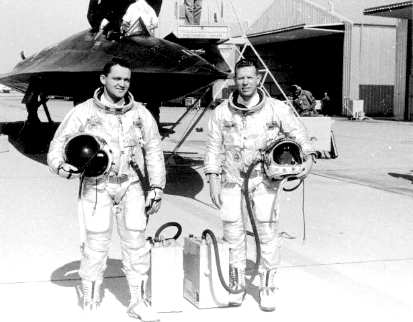
John F. Carnochan, RSO and Roy L. St.Martin, Pilot
Article One Follows:
(Courtesy of the Lovelock Review-Miner)
Article Two Follows:
(Courtesy of The Union)
Article Three Follows:
(Courtesy of The Sacramento Bee)
Go to Page #3 of "Blackbird Losses"
Loss: Page#1|Page#2|Page#3|Page#4
| SR-71 Front Page | Links Page | Index Page | Recollections | 2001 Reunion |
| "SR-71 Blackbirds" Web Site Navigator | ||||
| First Created: April 15, 1996 - Last Revised: March 29, 2004 | ||||
| Copyright © 1996 Leland R. Haynes Email: sr71webmaster@sr71.us | ||||